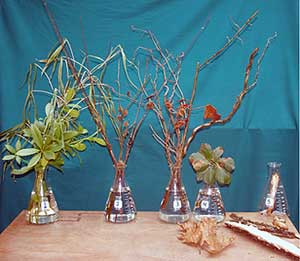January Color Appears at the Washington Park Arboretum

“Piercing, sucking and galling!”
1) Mites (on Sasa Bamboo and Skimmia)
- Stippling and yellowing of leaves are often indicative of the presence of mites.
- Feed by piercing underside of leaves and sucking chlorophyll out decreasing photosynthesis, reducing plant vigor and compromising the appearance.
- Mites are not insects; they are arachnids.
2) Galls (on Willow and Rose)
- Abnormal plant growths caused by various organisms (insects, mites, fungi, etc.)
- Galls are formed by increased production of normal plant hormones as response to feeding, egg-laying or disease infiltration and are often not harmful to the plant.
- Galls can be on leaves, stems, twigs, buds, flowers and roots
3) Blights (on Hazelnut and Cherry)
- Refers to a symptom affecting plants in response to infection by a pathogen.
- Blights come on rapidly and can cause complete chlorosis and browning of plant tissues such as leaves, branches and twigs; plant death is not uncommon.
- Aided by cool, moist conditions and limited air flow to plants…perfect for the Pacific Northwest!
4) Phylloxera (on Oak)
- Microscopic, yellow sucking aphid relatives that feed on leaves and buds.
- Yellowish spots on leaves in spring turn to brown by summer and defoliate.
- Repeated defoliation abates photosynthesis and can lead to plant death.
5) Armillaria root rots (shown on Bigleaf Maple, but many trees are susceptible)
- Fungus cause stunted leaves, chlorotic needles, dieback of twigs and branches and eventually death.
- Identified by white mats of fungal mycelium between the inner bark and wood and honey-brown mushrooms growing on or around the base of the tree.
- A big threat to the lumber industry as the wood is unsalvageable.